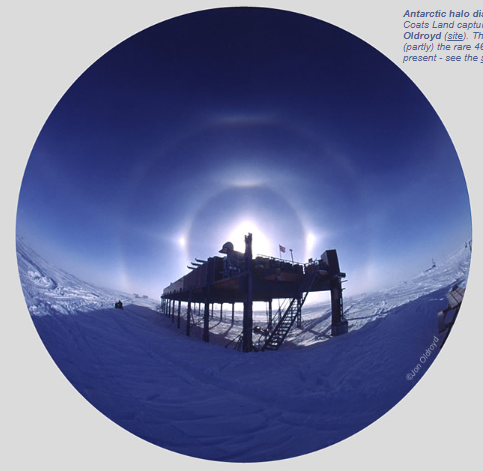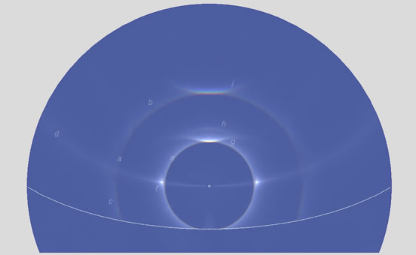46° Halo
The 46° Halo: A Rare and Enormous Atmospheric Phenomenon
The 46° halo is a rare and breathtaking optical phenomenon that stretches across the sky like two outspread hands from the sun. Unlike the everyday 22° halo, which appears as a ring around the sun, the 46° halo is much larger and more colorful. Its colors are pastel in nature, with a prominent red hue on the inside. However, it is important to note that if you see a fragment of a large colored halo twice as far from the sun as the 22° halo, it may not necessarily be a 46° halo. There are other similar halos, such as the supralateral and infralateral arcs, which can be mistaken for the rarer 46° halo.
To distinguish between the 46° halo and its look-alikes, it is essential to understand their characteristics. Here are some key points to help you differentiate between these halos:
- The 46° halo appears as a large circular halo around the sun, extending up to 46° from its center. It is rare and not commonly observed.
- Supralateral and infralateral arcs are often seen in a similar position to the 46° halo but have distinct features. The supralateral arc appears above the sun, while the infralateral arc appears below it.
- The colors of the 46° halo are spread out across its circumference, with red on the inside and no significant presence of greens or blues. In contrast, the supralateral and infralateral arcs exhibit a more fragmented color pattern.
Understanding these differences can enhance your appreciation of these atmospheric phenomena and allow you to accurately identify and marvel at the elusive 46° halo when you encounter it.
To provide a visual representation of these halos, ray trace simulations can be used. These simulations recreate the atmospheric conditions that lead to the formation of various halos. A simulation by HaloSim shows the different halos present in the sky, including the 46° halo, supralateral and infralateral arcs, parhelic circle, 22° halo, parhelia, tangent arc, Suncave Parry, and circumzenithal arc. The simulation uses crystal orientations and proportions to accurately depict the appearance of these halos.
It is important to note that the occurrence of the 46° halo depends on specific atmospheric conditions. The presence of certain types of ice crystals, such as random, column, Parry, and plate crystals, contributes to the formation of this halo. These crystals have different shapes and orientations, which influence the scattering and refraction of sunlight, resulting in the unique optical effects observed in the sky.
In conclusion, the 46° halo is a rare and awe-inspiring atmospheric phenomenon that captivates observers with its immense size and pastel colors. Distinguishing it from similar halos, such as the supralateral and infralateral arcs, requires careful observation and understanding of their distinctive features. Ray trace simulations offer a valuable tool for visualizing these halos and studying their formation. By delving into the science behind these optical phenomena, we can deepen our appreciation for the wonders of the natural world and the captivating beauty of the sky.

Antarctic halo display_ at Halley 5, Brunt Ice Shelf, Coats Land captured with a fisheye lens by____Jon Oldroyd____ (site). The large outer circular halo is (partly) the rare 46° halo. Several other halos are present - see the simulation. Image ©Jon Oldroyd._
The 46° halo is rare and huge. Two outspread hands from the sun, it spreads across the sky.
Its colours are also well spread. They are pastel with red on the inside and no real greens or blues.
__But -If you see a fragment of a very large coloured halo twice as far from the sun as the everyday 22°, it may__not be a 46° halo!
Supralateral and infralateral arcs lie in a similar position and are often mistaken for the rarer 46°.
See how to distinguish between the two halos.

Ray trace simulation byHaloSim._ Halos are: (a) 46°, (b) faint supralateral arc, (c) faint i_nfralateral arc, (d) parhelic circle (e) 22°, (f) parhelia, (g) tangent arc (h) Suncave Parry and (j) circumzenithal arc. Crystals were: random 54%, columns 20%, Parry 4% and plates 22%. Oriented crystals were given fairly large wobbles.
Note: this article has been automatically converted from the old site and may not appear as intended. You can find the original article here.
Reference Atmospheric Optics
If you use any of the definitions, information, or data presented on Atmospheric Optics, please copy the link or reference below to properly credit us as the reference source. Thank you!
-
<a href="https://atoptics.co.uk/blog/46-halo/">46° Halo</a>
-
"46° Halo". Atmospheric Optics. Accessed on April 27, 2024. https://atoptics.co.uk/blog/46-halo/.
-
"46° Halo". Atmospheric Optics, https://atoptics.co.uk/blog/46-halo/. Accessed 27 April, 2024
-
46° Halo. Atmospheric Optics. Retrieved from https://atoptics.co.uk/blog/46-halo/.